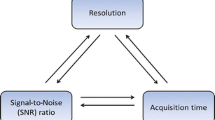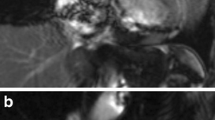Abstract
MRI is an important additional tool in the diagnostic work-up of children with congenital heart disease. This review aims to summarise the role MRI has in this patient population. Echocardiography remains the main diagnostic tool in congenital heart disease. In specific situations, MRI is used for anatomical imaging of congenital heart disease. This includes detailed assessment of intracardiac anatomy with 2-D and 3-D sequences. MRI is particularly useful for assessment of retrosternal structures in the heart and for imaging large vessel anatomy. Functional assessment includes assessment of ventricular function using 2-D cine techniques. Of particular interest in congenital heart disease is assessment of right and single ventricular function. Two-dimensional and newer 3-D techniques to quantify flow in these patients are or will soon become an integral part of quantification of shunt size, valve function and complex flow patterns in large vessels. More advanced uses of MRI include imaging of cardiovascular function during stress and tissue characterisation of the myocardium. Techniques used for this purpose need further validation before they can become part of the daily routine of MRI assessment of congenital heart disease.







Similar content being viewed by others
References
van der Linde D, Konings EE, Slager MA et al (2011) Birth prevalence of congenital heart disease worldwide: a systematic review and meta-analysis. J Am Coll Cardiol 58:2241–2247
Stuart AG (2012) Changing lesion demographics of the adult with congenital heart disease: an emerging population with complex needs. Futur Cardiol 8:305–313
Marelli AJ, Mackie AS, Ionescu-Ittu R et al (2007) Congenital heart disease in the general population: changing prevalence and age distribution. Circulation 115:163–172
Beels L, Bacher K, De Wolf D et al (2009) Gamma-H2AX foci as a biomarker for patient X-ray exposure in pediatric cardiac catheterization: are we underestimating radiation risks? Circulation 120:1903–1909
Fratz S, Chung T, Greil GF et al (2013) Guidelines and protocols for cardiovascular magnetic resonance in children and adults with congenital heart disease: SCMR expert consensus group on congenital heart disease. J Cardiovasc Magn Reson 15:51
Valsangiacomo Buechel ER, Grosse-Wortmann L, Fratz S et al. (2014) Indications for cardiovascular magnetic resonance in children with congenital and acquired heart disease - An expert consensus paper of the Imaging Working Group of the AEPC and the Cardiovascular Magnetic Resonance Section of the EACVI. Eur Heart J Cardiovasc Imaging AND Cardiology in the Young in press.
Anderson RH, Becker AE, Freedom RM et al (1984) Sequential segmental analysis of congenital heart disease. Pediatr Cardiol 5:281–287
Razavi RS, Hill DL, Muthurangu V et al (2003) Three-dimensional magnetic resonance imaging of congenital cardiac anomalies. Cardiol Young 13:461–465
Sorensen TS, Korperich H, Greil GF et al (2004) Operator-independent isotropic three-dimensional magnetic resonance imaging for morphology in congenital heart disease: a validation study. Circulation 110:163–169
Feder E, Meisner H, Bühlmeyer K et al (1980) Operative treatment of TGA: comparison of senning’s and mustard’s operation in patients under 2 years. Thorac Cardiovasc Surg 28:7–12
Khairy P, Poirier N, Mercier L-A (2007) Univentricular heart. Circulation 115:800–812
Grosse-Wortmann L, Al-Otay A, Woo Goo H et al (2007) Anatomical and functional evaluation of pulmonary veins in children by magnetic resonance imaging. J Am Coll Cardio 49:993–1002
Kellenberger C (2010) Aortic arch malformations. Pediatr Radiol 40:876–884
Knobel Z, Kellenberger C, Kaiser T et al (2011) Geometry and dimensions of the pulmonary artery bifurcation in children and adolescents: assessment in vivo by contrast-enhanced MR-angiography. Int J Cardiovasc Imaging 27:385–396
Konen E, Merchant N, Provost Y et al (2004) Coarctation of the aorta before and after correction: the role of cardiovascular MRI. AJR Am J Roentgenol 182:1333–1339
Norozi K, Wessel A, Alpers V et al (2006) Incidence and risk distribution of heart failure in adolescents and adults with congenital heart disease after cardiac surgery. Am J Cardiol 97:1238–1243
Helbing WA, Bosch HG, Maliepaard C et al (1995) Comparison of echocardiographic methods with magnetic resonance imaging for assessment of right ventricular function in children. Am J Cardiol 76:589–594
Sheehan FH, Ge S, Vick GW 3rd et al (2008) Three-dimensional shape analysis of right ventricular remodeling in repaired tetralogy of Fallot. Am J Cardiol 101:107–113
Rebergen SA, van der Wall EE, Helbing WA et al (1996) Quantification of pulmonary and systemic blood flow by magnetic resonance velocity mapping in the assessment of atrial-level shunts. Int J Card Imaging 12:143–152
Rebergen SA, Helbing WA, van der Wall EE et al (1995) MR velocity mapping of tricuspid flow in healthy children and in patients who have undergone Mustard or Senning repair. Radiology 194:505–512
Rebergen SA, van der Wall EE, Doornbos J et al (1993) Magnetic resonance measurement of velocity and flow: technique, validation, and cardiovascular applications. Am Heart J 126:1439–1456
Rebergen SA, Chin JG, Ottenkamp J et al (1993) Pulmonary regurgitation in the late postoperative follow-up of tetralogy of Fallot. Volumetric quantitation by nuclear magnetic resonance velocity mapping. Circulation 88:2257–2266
Rebergen SA, Ottenkamp J, Doornbos J et al (1993) Postoperative pulmonary flow dynamics after Fontan surgery: assessment with nuclear magnetic resonance velocity mapping. J Am Coll Cardiol 21:123–131
Alfakih K, Plein S, Thiele H et al (2003) Normal human left and right ventricular dimensions for MRI as assessed by turbo gradient echo and steady-state free precession imaging sequences. J Magn Reson Imaging 17:323–329
Buechel EV, Kaiser T, Jackson C et al (2009) Normal right- and left ventricular volumes and myocardial mass in children measured by steady state free precession cardiovascular magnetic resonance. J Cardiovasc Magn Reson 11:19
Robbers-Visser D, Boersma E, Helbing WA (2009) Normal biventricular function, volumes, and mass in children aged 8 to 17 years. J Magn Reson Imaging 29:552–559
Sarikouch S, Peters B, Gutberlet M et al (2010) Sex-specific pediatric percentiles for ventricular size and mass as reference values for cardiac MRI: assessment by steady-state free-precession and phase-contrast MRI flow. Circ Cardiovasc Imaging 3:65–76
Luijnenburg S, Robbers-Visser D, Moelker A et al (2010) Intra-observer and interobserver variability of biventricular function, volumes and mass in patients with congenital heart disease measured by CMR imaging. Int J Cardiovasc Imaging 26:57–64
Fratz S, Schuhbaeck A, Buchner C et al (2009) Comparison of accuracy of axial slices versus short-axis slices for measuring ventricular volumes by cardiac magnetic resonance in patients with corrected tetralogy of Fallot. Am J Cardiol 103:1764–1769
Strugnell WE, Slaughter IR, Riley RA et al (2005) Modified RV short axis series–a new method for cardiac MRI measurement of right ventricular volumes. J Cardiovasc Magn Reson 7:769–774
Beerbaum P, Körperich H, Barth P et al (2001) Noninvasive quantification of left-to-right shunt in pediatric patients: phase-contrast cine magnetic resonance imaging compared with invasive oximetry. Circulation 103:2476–2482
Grosse-Wortmann L, Al-Otay A, Yoo S-J (2009) Aortopulmonary collaterals after bidirectional cavopulmonary connection or Fontan completion: quantification with MRI. Circ Cardiovasc Imaging 2:219–225
Kilner PJ, Gatehouse PD, Firmin DN (2007) Flow measurement by magnetic resonance: a unique asset worth optimising. J Cardiovasc Magn Reson 9:723–728
Kozerke S, Hasenkam JM, Nygaard H et al (2001) Heart motion-adapted MR velocity mapping of blood velocity distribution downstream of aortic valve prostheses: initial experience. Radiology 218:548–555
Vogt F, Theysohn J, Michna D et al (2013) Contrast-enhanced time-resolved 4D MRA of congenital heart and vessel anomalies: image quality and diagnostic value compared with 3D MRA. Eur Radiol 23:2392–2404
Valverde I, Nordmeyer S, Uribe S et al (2012) Systemic-to-pulmonary collateral flow in patients with palliated univentricular heart physiology: measurement using cardiovascular magnetic resonance 4D velocity acquisition. J Cardiovasc Magn Reson 14:25
Luijnenburg SE, Peters RE, van der Geest RJ et al (2013) Abnormal right atrial and right ventricular diastolic function relate to impaired clinical condition in patients operated for tetralogy of Fallot. Int J Cardiol 167:833–839
Kempny A, Fernandez-Jimenez R, Orwat S et al (2012) Quantification of biventricular myocardial function using cardiac magnetic resonance feature tracking, endocardial border delineation and echocardiographic speckle tracking in patients with repaired tetralogy of fallot and healthy controls. J Cardiovasc Magn Reson 14:32
Robbers-Visser D, Luijnenburg SE, van den Berg J et al (2009) Stress imaging in congenital cardiac disease. Cardiol Young 19:552–562
Luijnenburg SE, Mekic S, van den Berg J et al (2013) Ventricular response to dobutamine stress relates to the change in peak oxygen uptake during the 5-year follow-up in young patients with repaired tetralogy of Fallot. Eur Heart J Cardiovasc Imaging 15:189–194
Winter MM, Scherptong RWC, Kumar S et al (2010) Ventricular response to stress predicts outcome in adult patients with a systemic right ventricle. Am Heart J 160:870–876
Jellis C, Martin J, Narula J et al (2010) Assessment of nonischemic myocardial fibrosis. J Am Coll Cardiol 56:89–97
Messroghli DR, Radjenovic A, Kozerke S et al (2004) Modified Look-Locker inversion recovery (MOLLI) for high-resolution T1 mapping of the heart. Magn Reson Med 52:141–146
Conflicts of interest
None
Author information
Authors and Affiliations
Corresponding author
Rights and permissions
About this article
Cite this article
Helbing, W.A., Ouhlous, M. Cardiac magnetic resonance imaging in children. Pediatr Radiol 45, 20–26 (2015). https://doi.org/10.1007/s00247-014-3175-x
Received:
Revised:
Accepted:
Published:
Issue Date:
DOI: https://doi.org/10.1007/s00247-014-3175-x




